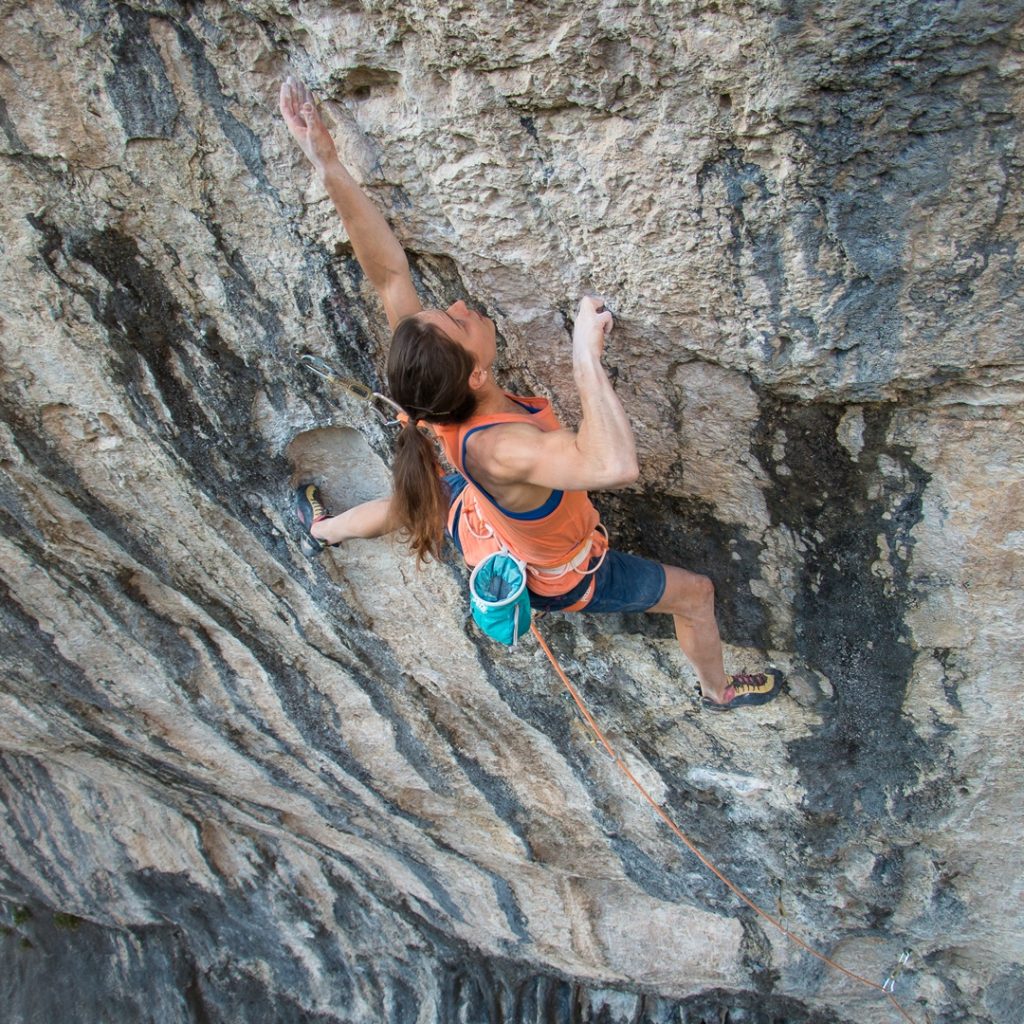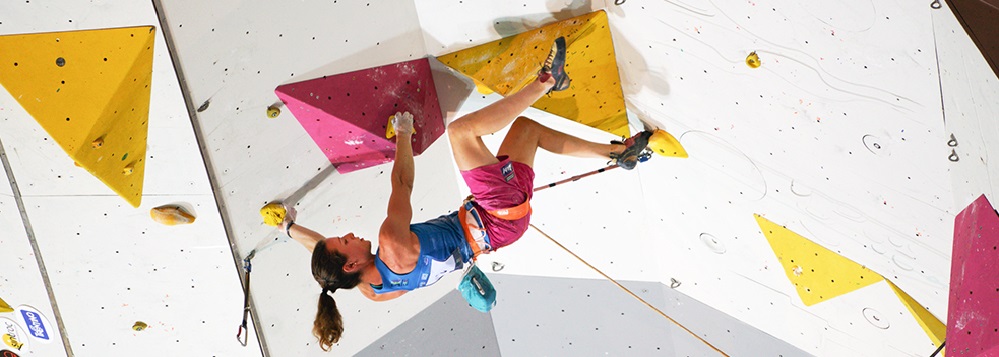… was no option this year, but I’m looking forward to doing hard moves again once my elbow is healed! ?
So for now: full focus on the rehab!

Photo by @seb_richard26
Sweet neuf – 9a+, September 2017

… was no option this year, but I’m looking forward to doing hard moves again once my elbow is healed! ?
So for now: full focus on the rehab!

Photo by @seb_richard26
Sweet neuf – 9a+, September 2017
Since September 2017 I am suffering from an elbow injury.
I prepared the 2018 season as well as I could, combining hard training with trying lots of different therapies and doing the many prescribed exercises. I thought I was going to be more than ready when the season started. Unfortunately it was not exactly as I had hoped.
I was in a pretty good shape when the competition season started in July, but I still suffered a lot from the injury.
The pain wasn’t gone and was getting worse: I was pumped faster than usual and had to handle a loss of strength caused by a constant hypertension in the muscles of my arm.
Nevertheless, after quite a bit of hesitation, I decided to start the season and despite the injury, 2 foot slips and some time-outs, I still got 2 bronze medals.
After the world championships I decided to stop my competition season even though there were 3 more world cups on the calendar. It was a difficult decision, but I think I made the right one. This way I have more time to rehabilitate between my last competition and the start of the next training program.
I did a bit of easy multi pitching before I stopped climbing completely in the beginning of October in order to start a rehabilitation program.
The physiotherapist I recently started working with is convinced that one of the causes of my elbow injury is an imbalance in my shoulders and hips. So I started an all-body rehab by doing mobilization and stabilization exercises. That should be good for my whole body as well as for my elbows.
After 2 weeks, I had already made some nice progress and we were able to add some elbow-specific (eccentric) exercises to the program.
There are still climbing goals that I would like to achieve, but right now I need to be completely focused on the rehab of my injury.
It is a time with quite a bit of uncertainty and questions, but I’m grateful for what I can learn throughout the process.
One of the most difficult decisions I’ve ever had to make:
My competition season will end right now and I will not compete in the upcoming world cups of 2018.
I have been struggling with a serious elbow injury for about a year now. I tried to do all I could to take care of the injury by searching for professional help, trying out different kinds of therapies, doing injury prevention training and tendon strengthening exercises.
It’s been a very tough year.
But it has also been a year full of learning and character shaping. And I know those things were not in vain.
An overview of the competitions I have done so far this year:
February 24th Gripped: 1st place
This Belgian Masters competition in ‘Klimzaal de Stordeur’ had a special format:
– It was an ‘after-work’ competition: the climbers had 2 times 11 minutes to check out the route.
– The route split up in the middle: the climbers had to choose between going left or right.
– All climbers had 1 ‘real’ attempt to climb as high as possible
May 13th Belgian Lead Championship: 1st place
July 7th World Cup Villars, SUI: 27th place
What a tough start of the lead world cup season for me: a foot slip and a last place in semi finals. ?
This was the first time I missed a final round on a world cup since my first finals in 2013. Knowing that, I can be thankful for all those times I did make finals. ?
July 13th World Cup Chamonix, FRA: 6th place
At this world cup I reached finals again. While climbing the final route, I timed out and I became 6th.
July 21nd World Cup Briançon, FRA: 3rd place
I had 2 tops in the qualification round, a time out but still a high score in the semi final route and I just missed the last hold in finals.
Overall I’m happy with how this competition went and I’m especially thankful realizing that I’ve been dealing with a serious elbow injury since last September.
July 28th World Cup Arco, ITA: 3rd place
I still ended up in 3rd place after a time-out in the final route which stopped me before I had given it my all. I’m satisfied with the climbing I did do though. ?
July 29th Rock Master Duel, Arco, ITA: 3rd place
Thankful for my bronze medal at the Arco Rock Master Duel, a knockout speed/lead competition which takes place every year after the world cup.
Same podium as in the World Cup the previous day with Janja in first place and Jessy in second.
Rock climbing in the big cave (‘Cova Gran’) of Santa Linya in Catalunya (Spain).
Here I first sent Ciudad de Dios (a route graded 9a or 9a/+).
Some days later, on December 10th, I climbed the route again. This time I didn’t stop at the belay, but continued into the second part of a route called La Novena Enmienda. That meant adding more than 20 meters to Ciudad de Dios and climbing all the way to the top of the cave. The total lenght of the route must be something like 50 meters.
By climbing this new combination, I have probably done the first ascent of it. The name of this link-up is now ‘Ciudad de Dios pa la Enmienda’.
I was grateful that I was still able to climb hard after a long and tiring season and with some circumstances that made climbing pretty uncomfortable: an aching elbow, some humid rock and frozen toes halfway up the route.
The grade?
Tough question.
The guidebook calls Ciudad de Dios a 9a/+. That would certainly make the extension I climbed a 9a+.
However, Edu Marin thinks Ciudad de Dios might have become 9a over the years due to new methods. And then the link-up would be a 9a/+.
So what should I say?
I think I know…
I’ll call it a 9a/++. ?
Ciudad de Dios pa la Enmienda is long, skin-friendly and the hardest move is situated right in the beginning.
After having climbed the short, but very intense and bouldery start (probably around 8c+), you get to a place where you can shake out. Then you continue into a crux of La Fabelita 8c: a traverse to the left, followed by another good rest. Some meters higher you find yourself doing the crux of La Fabela 8c+, again traversing leftwards, and a few tricky moves later, you’ve climbed Ciudad de Dios (a 9a or 9a/+, depending on who you ask).
Here, next to the chain of Ciudad de Dios, you can take a breath and chalk up. When you feel like you’re ready to continue, you climb a few meters straight up. At this point I had to put my feet on small, slopy footholds and stretch out to take a high undercling. And then I realized I couldn’t feel my toes anymore because of the cold! I couldn’t go back and didn’t want to fall, so I just pushed on my feet, even though they felt like ice cubes. It worked. Phew!
And then starts the long traverse to the right: the last part of La Novena Enmienda. This second half of the route contains several little cruxes with moves that are far and risky for people my size. I had already noticed that the rock was a little humid, but at a certain moment, right before I had to commit to a far move, I could feel the moisture inside an undercling. “Go on, there’s no way back”, I told myself and… I made it. Move after move, I had to keep being precise and recover as much as I could.
At the very end of the route, right before the chain, I had to put all my wait on a slippery, shiny foothold to make a high kneedrop. “Stay on, don’t slip off…” My foot stayed on: another ‘phew’!
And then it was time to clip the chain.
An interview with me by Pol Ortiz on Wogü.es (in Spanish).
What a great experience it was to top the on sight route and win the competition with such an excited crowd behind me!
The comp was organized by Climb Up Lyon to celebrate the 20th anniversary of the gym ‘Mur de Lyon’ in France.
You can watch the replay of the competition here (I climb at around 1:02:00).
And a video made by High Rock Climbing: